Abstract
We determined the MBC of amoxicillin and vancomycin, two antibiotics advocated for treatment and prophylaxis of bacterial endocarditis, for 24 strains of viridans group streptococci isolated from patients with endocarditis. We found that the MIC of amoxicillin for all strains was less than or equal to 0.25 micrograms/ml and the MBC was either low (less than 0.5 micrograms/ml) in 6 nontolerant strains or high (greater than 128 micrograms/ml) in 18 tolerant strains. The MIC of vancomycin for the 24 strains was less than or equal to 1 microgram/ml, and the MBC was either low (less than 1 microgram/ml) for 3 nontolerant strains or high (greater than 128 micrograms/ml) for 21 tolerant strains. In addition to the MBC, we determined the actual reduction of the viable bacterial counts in each tube dilution after 24 h of incubation. This determination was made by subtracting the number of colonies observed on the subculture plate from the number of bacteria contained in the initial inoculum. For both antibiotics we found that the maximal reduction in viable counts was achieved at or very close to the MIC and did not increase with increasing antibiotic concentrations (up to 128 micrograms/ml). As expected, the six strains for which the amoxicillin MBC was less than 0.5 micrograms/ml and the three strains for which the vancomycin MBC was less than 1 microgram/ml had a reduction of viable counts of more than 3 log10 (greater than 99.9% killing). In contrast, among the strains defined as tolerant to amoxicillin and vancomycin, there were wide variations in the actual reduction of bacterial counts, ranging from 3 log10 to less than 1 log10. Therefore our observations suggest that the reduction of viable streptococcal counts reflects more accurately the bactericidal effect of amoxicillin and vancomycin than does the MBC, which artificially divides the strains into sensitive or tolerant strains.
Full text
PDF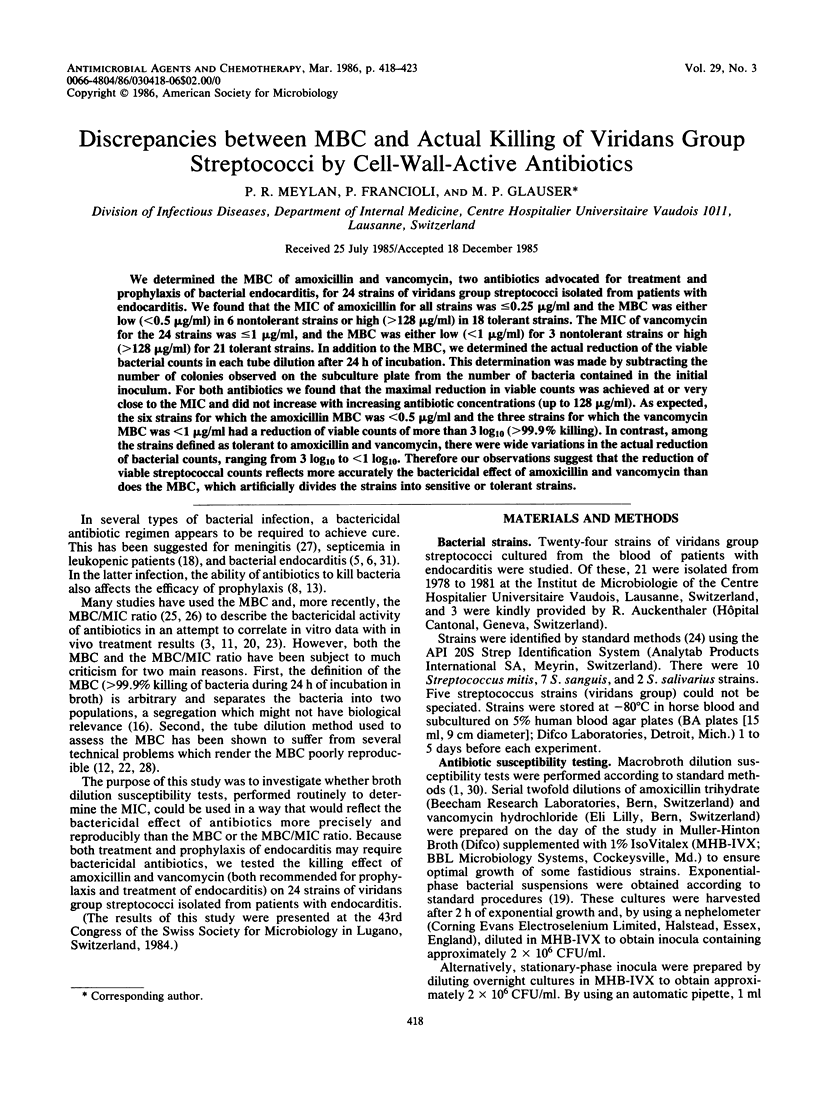
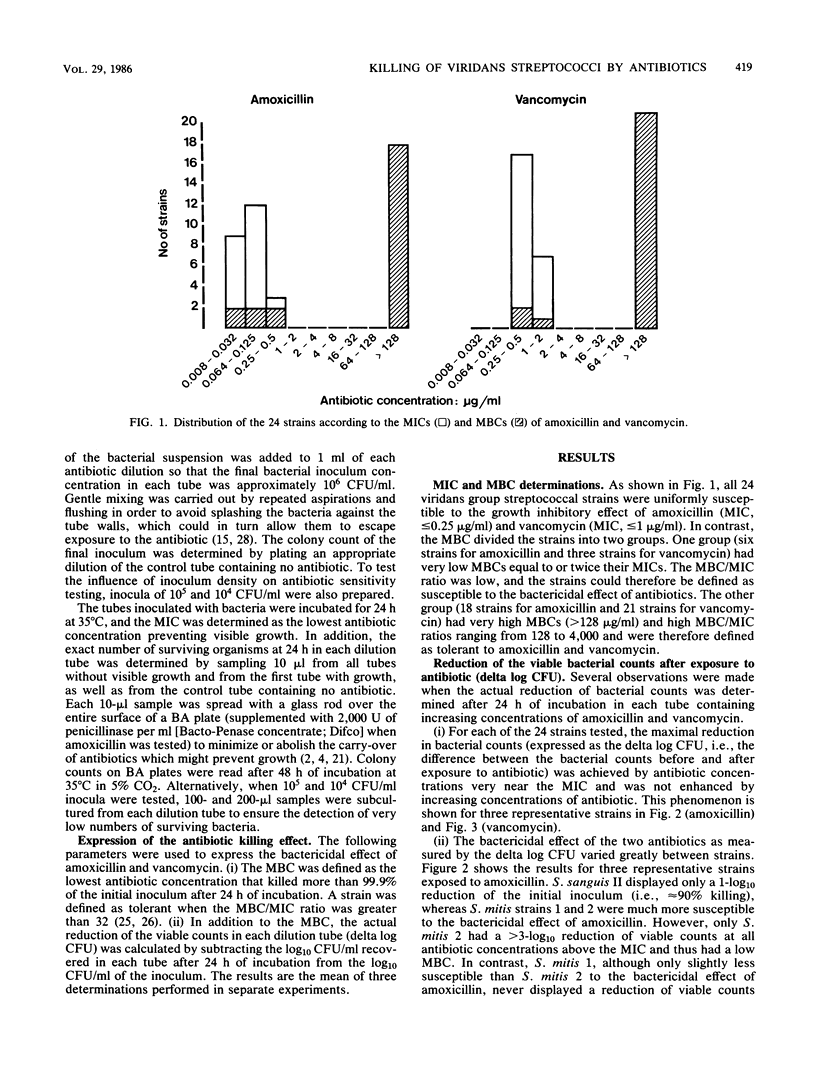
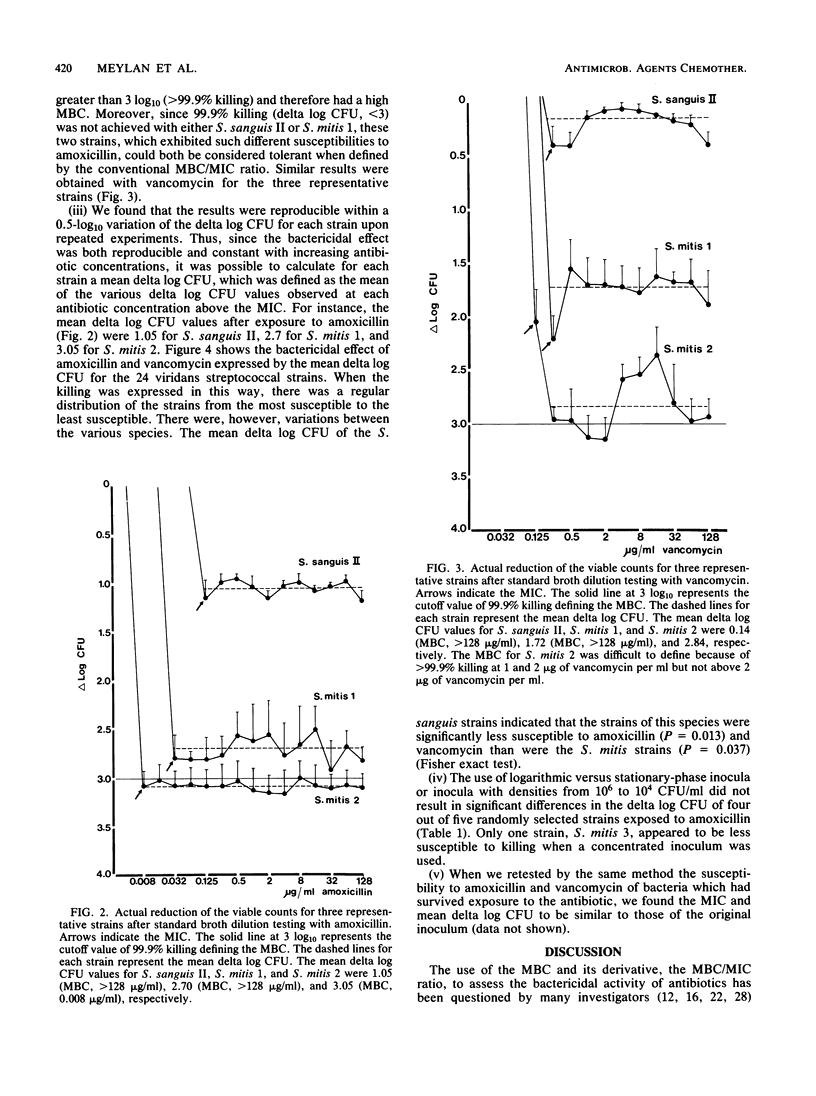
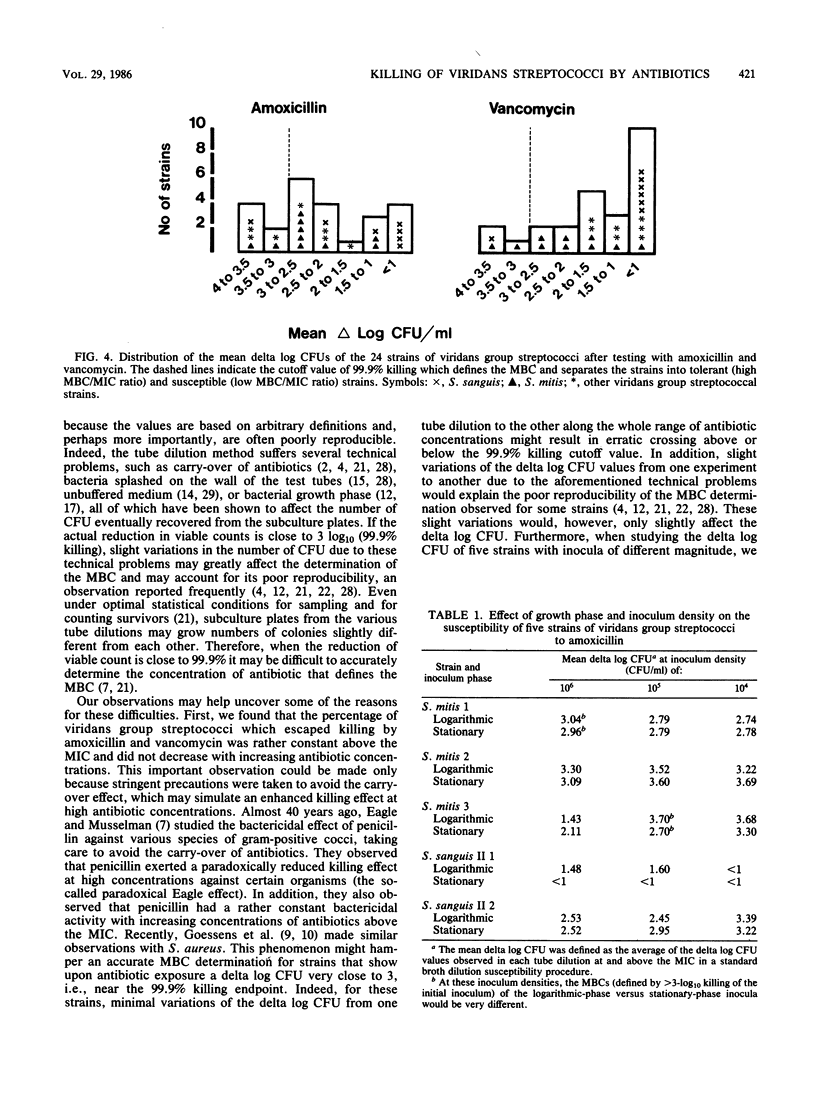
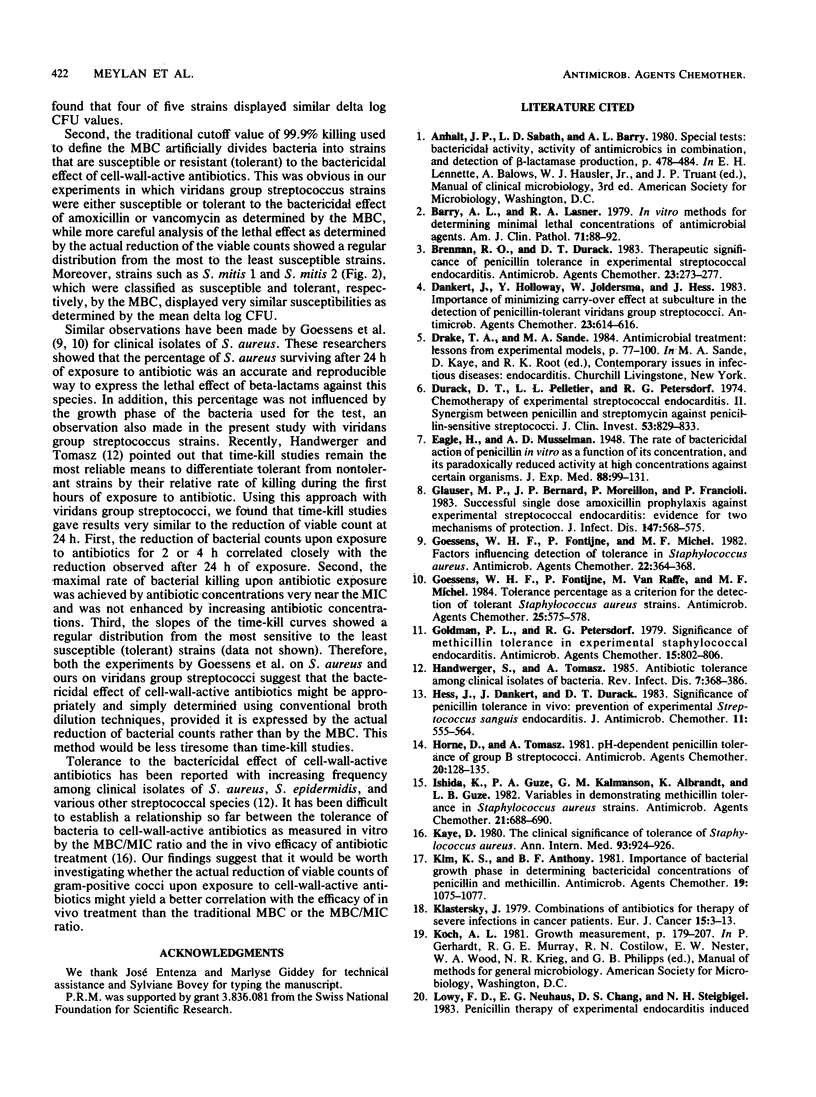
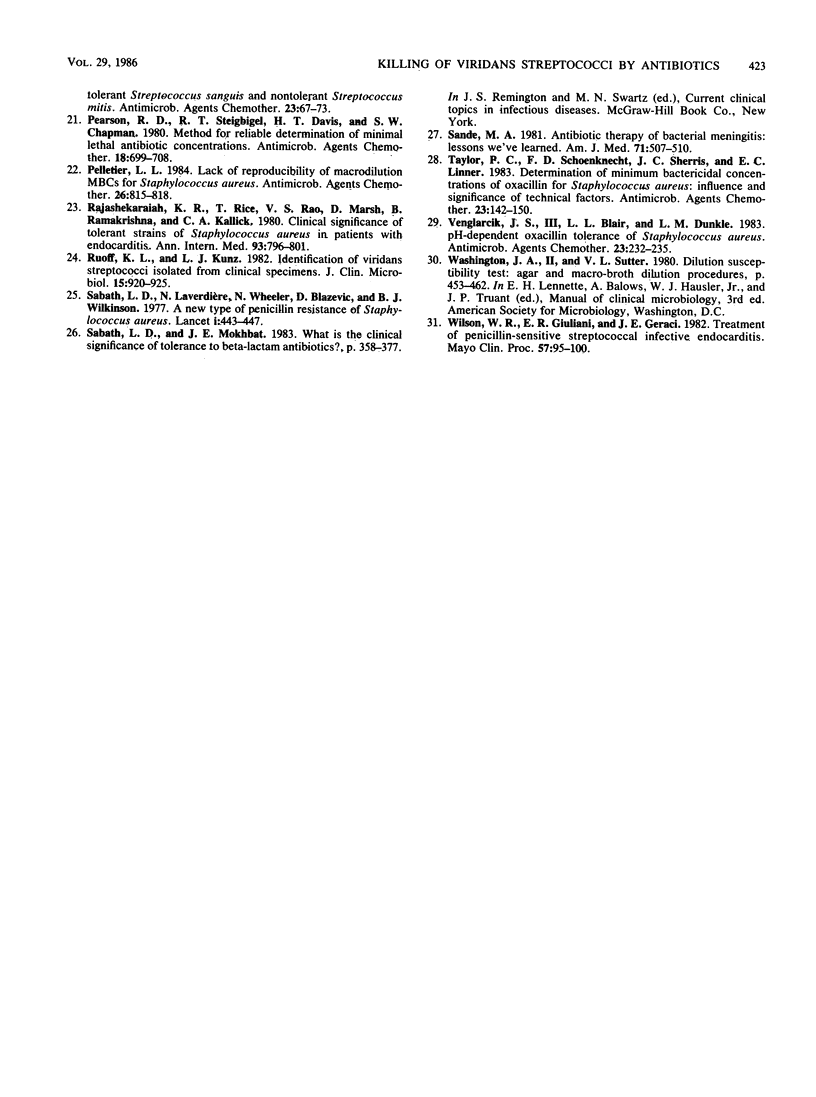
Selected References
These references are in PubMed. This may not be the complete list of references from this article.
- Barry A. L., Lasner R. A. In-vitro methods for determining minimal lethal concentrations of antimicrobial agents. Am J Clin Pathol. 1979 Jan;71(1):88–92. doi: 10.1093/ajcp/71.1.88. [DOI] [PubMed] [Google Scholar]
- Brennan R. O., Durack D. T. Therapeutic significance of penicillin tolerance in experimental streptococcal endocarditis. Antimicrob Agents Chemother. 1983 Feb;23(2):273–277. doi: 10.1128/aac.23.2.273. [DOI] [PMC free article] [PubMed] [Google Scholar]
- Dankert J., Holloway Y., Joldersma W., Hess J. Importance of minimizing carry-over effect at subculture in the detection of penicillin-tolerant viridans group streptococci. Antimicrob Agents Chemother. 1983 Apr;23(4):614–616. doi: 10.1128/aac.23.4.614. [DOI] [PMC free article] [PubMed] [Google Scholar]
- Durack D. T., Pelletier L. L., Petersdorf R. G. Chemotherapy of experimental streptococcal endocarditis. II. Synergism between penicillin and streptomycin against penicillin-sensitive streptococci. J Clin Invest. 1974 Mar;53(3):829–833. doi: 10.1172/JCI107622. [DOI] [PMC free article] [PubMed] [Google Scholar]
- Glauser M. P., Bernard J. P., Moreillon P., Francioli P. Successful single-dose amoxicillin prophylaxis against experimental streptococcal endocarditis: evidence for two mechanisms of protection. J Infect Dis. 1983 Mar;147(3):568–575. doi: 10.1093/infdis/147.3.568. [DOI] [PubMed] [Google Scholar]
- Goessens W. H., Fontijne P., Michel M. F. Factors influencing detection of tolerance in Staphylococcus aureus. Antimicrob Agents Chemother. 1982 Sep;22(3):364–368. doi: 10.1128/aac.22.3.364. [DOI] [PMC free article] [PubMed] [Google Scholar]
- Goessens W. H., Fontijne P., van Raffe M., Michel M. F. Tolerance percentage as a criterion for the detection of tolerant Staphylococcus aureus strains. Antimicrob Agents Chemother. 1984 May;25(5):575–578. doi: 10.1128/aac.25.5.575. [DOI] [PMC free article] [PubMed] [Google Scholar]
- Goldman P. L., Petersdorf R. G. Significance of methicillin tolerance in experimental staphylococcal endocarditis. Antimicrob Agents Chemother. 1979 Jun;15(6):802–806. doi: 10.1128/aac.15.6.802. [DOI] [PMC free article] [PubMed] [Google Scholar]
- Handwerger S., Tomasz A. Antibiotic tolerance among clinical isolates of bacteria. Rev Infect Dis. 1985 May-Jun;7(3):368–386. doi: 10.1093/clinids/7.3.368. [DOI] [PubMed] [Google Scholar]
- Hess J., Dankert J., Durack D. Significance of penicillin tolerance in vivo: prevention of experimental Streptococcus sanguis endocarditis. J Antimicrob Chemother. 1983 Jun;11(6):555–564. doi: 10.1093/jac/11.6.555. [DOI] [PubMed] [Google Scholar]
- Horne D., Tomasz A. pH-dependent penicillin tolerance of group B streptococci. Antimicrob Agents Chemother. 1981 Jul;20(1):128–135. doi: 10.1128/aac.20.1.128. [DOI] [PMC free article] [PubMed] [Google Scholar]
- Ishida K., Guze P. A., Kalmanson G. M., Albrandt K., Guze L. B. Variables in demonstrating methicillin tolerance in Staphylococcus aureus strains. Antimicrob Agents Chemother. 1982 Apr;21(4):688–690. doi: 10.1128/aac.21.4.688. [DOI] [PMC free article] [PubMed] [Google Scholar]
- Kaye D. The clinical significance of tolerance of Staphylococcus aureus. Ann Intern Med. 1980 Dec;93(6):924–926. doi: 10.7326/0003-4819-93-6-924. [DOI] [PubMed] [Google Scholar]
- Kim K. S., Anthony B. F. Importance of bacterial growth phase in determining minimal bactericidal concentrations of penicillin and methicillin. Antimicrob Agents Chemother. 1981 Jun;19(6):1075–1077. doi: 10.1128/aac.19.6.1075. [DOI] [PMC free article] [PubMed] [Google Scholar]
- Klastersky J. Combinations of antibiotics for therapy of severe infections in cancer patients. Eur J Cancer. 1979;15 (Suppl):3–13. [PubMed] [Google Scholar]
- Lowy F. D., Neuhaus E. G., Chang D. S., Steigbigel N. H. Penicillin therapy of experimental endocarditis induced by tolerant Streptococcus sanguis and nontolerant Streptococcus mitis. Antimicrob Agents Chemother. 1983 Jan;23(1):67–73. doi: 10.1128/aac.23.1.67. [DOI] [PMC free article] [PubMed] [Google Scholar]
- Pearson R. D., Steigbigel R. T., Davis H. T., Chapman S. W. Method of reliable determination of minimal lethal antibiotic concentrations. Antimicrob Agents Chemother. 1980 Nov;18(5):699–708. doi: 10.1128/aac.18.5.699. [DOI] [PMC free article] [PubMed] [Google Scholar]
- Pelletier L. L., Jr Lack of reproducibility of macrodilution MBCs for Staphylococcus aureus. Antimicrob Agents Chemother. 1984 Dec;26(6):815–818. doi: 10.1128/aac.26.6.815. [DOI] [PMC free article] [PubMed] [Google Scholar]
- Ruoff K. L., Kunz L. J. Identification of viridans streptococci isolated from clinical specimens. J Clin Microbiol. 1982 May;15(5):920–925. doi: 10.1128/jcm.15.5.920-925.1982. [DOI] [PMC free article] [PubMed] [Google Scholar]
- Sabath L. D., Wheeler N., Laverdiere M., Blazevic D., Wilkinson B. J. A new type of penicillin resistance of Staphylococcus aureus. Lancet. 1977 Feb 26;1(8009):443–447. doi: 10.1016/s0140-6736(77)91941-9. [DOI] [PubMed] [Google Scholar]
- Sande M. A. Antibiotic therapy of bacterial meningitis: lessons we've learned. Am J Med. 1981 Oct;71(4):507–510. doi: 10.1016/0002-9343(81)90191-1. [DOI] [PubMed] [Google Scholar]
- Taylor P. C., Schoenknecht F. D., Sherris J. C., Linner E. C. Determination of minimum bactericidal concentrations of oxacillin for Staphylococcus aureus: influence and significance of technical factors. Antimicrob Agents Chemother. 1983 Jan;23(1):142–150. doi: 10.1128/aac.23.1.142. [DOI] [PMC free article] [PubMed] [Google Scholar]
- Venglarcik J. S., 3rd, Blair L. L., Dunkle L. M. pH-dependent oxacillin tolerance of Staphylococcus aureus. Antimicrob Agents Chemother. 1983 Feb;23(2):232–235. doi: 10.1128/aac.23.2.232. [DOI] [PMC free article] [PubMed] [Google Scholar]
- Wilson W. R., Giuliani E. R., Geraci J. E. Treatment of penicillin-sensitive streptococcal infective endocarditis. Mayo Clin Proc. 1982 Feb;57(2):95–100. [PubMed] [Google Scholar]


